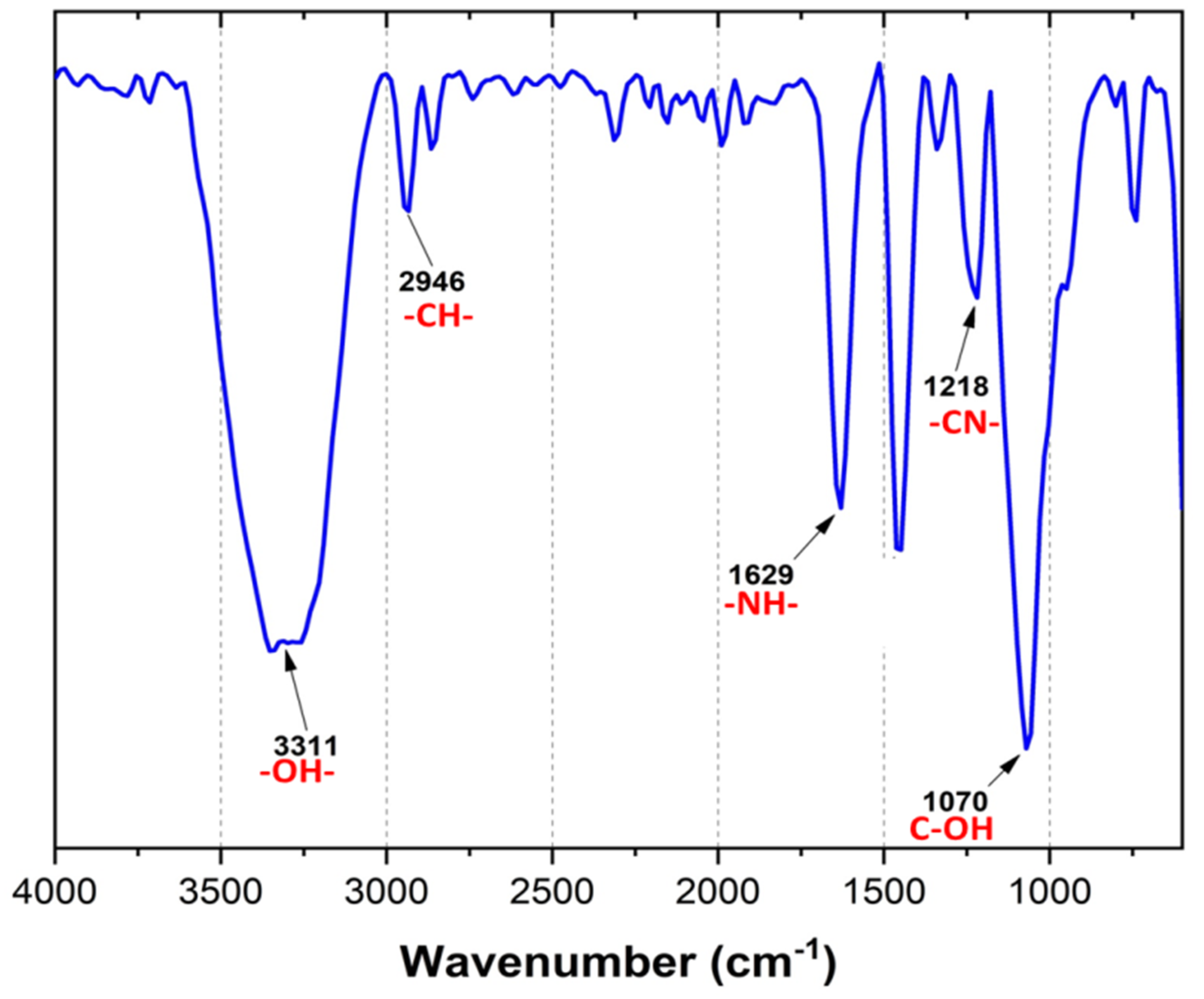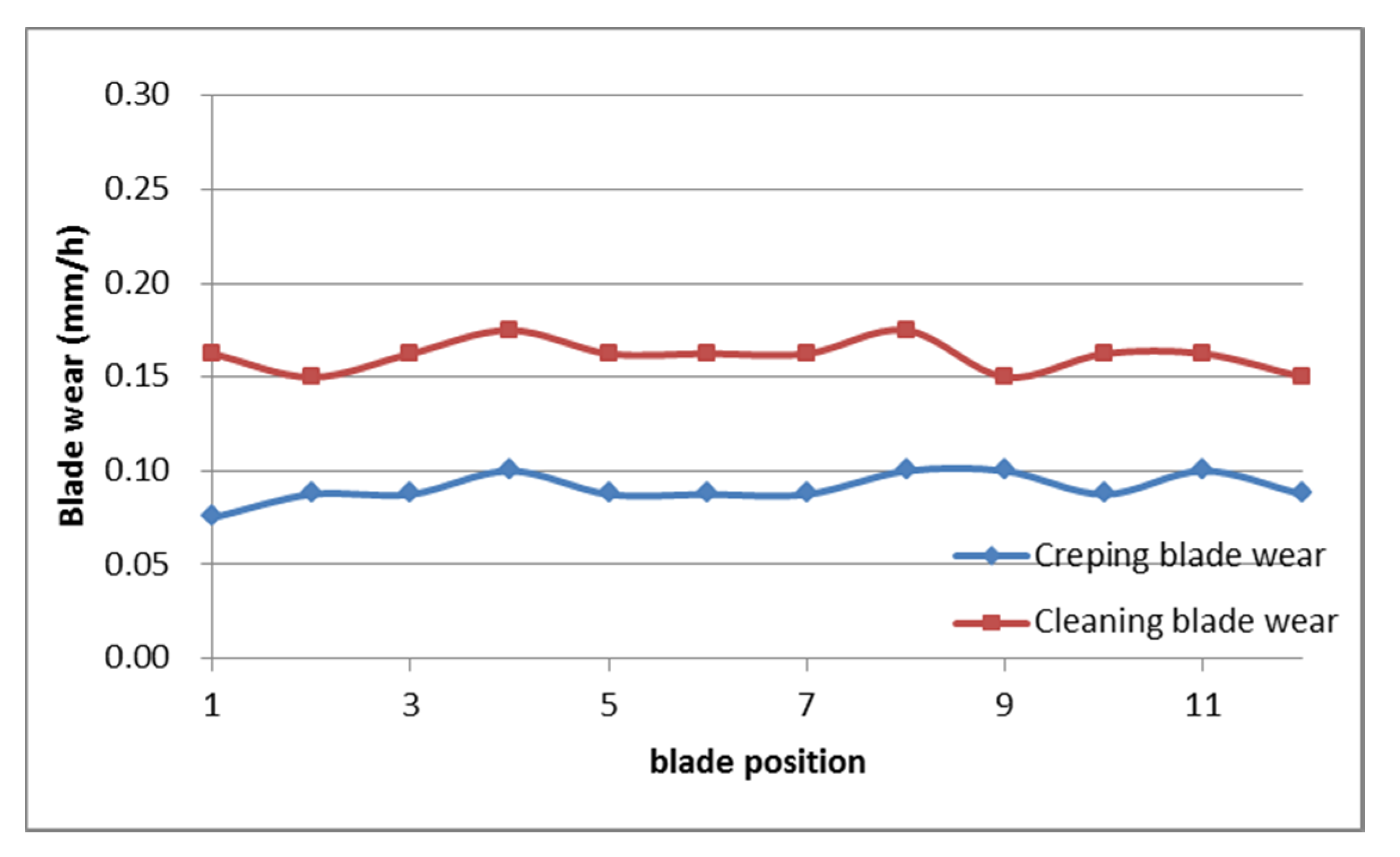Synthesis and Application of a Cationic Polyamine as Yankee Dryer Coating Agent for the Tissue Paper-Making Process
Abstract
1. Introduction
2. Materials and Methods
2.1. Materials
2.2. Synthesis of the Polyamine Resin Polycoat 38®
2.3. Characterization
2.3.1. Characterization of the Polycoat 38®
2.3.2. Characterization of the Tissue Creping Paper
2.4. Application of the Polycoat 38® and the Disprosol 17® in the Yankee Dryer
3. Results and Discussion
3.1. FTIR Analysis of the Polycoat 38® Resin
3.2. 1H-NMR Analysis of the Polycoat 38® Resin
3.3. Molecular Weight Determination of the Polycoat 38® Resin
3.4. Thermogravimetric Analysis (TGA) of the Polycoat 38® Resin
3.5. Differential Scanning Calorimetry (DSC) of the PAE Resin
3.6. Relative Adhesion of Polycoat 38®
3.7. Durability Test of the Polycoat 38®
3.8. Quality Parameters of the Polycoat 38 Resin and Disprosol 17 Release Agent
3.9. Application of the Polycoat 38 Along with Disprosol 17 as Yankee Dryer Coating-Release Agent
3.10. Quality Parameters of the Tissue Creping Paper Obtained
3.10.1. Caliber of the Tissue Creping Paper Obtained
3.10.2. Tensile Strength and Stretch of the Creping Paper Obtained
4. Conclusions
Author Contributions
Funding
Acknowledgments
Conflicts of Interest
References
- The Basics of Creping in the Tissuemaking Process. Available online: https://www.tissuestory.com/2018/09/26/the-basics-of-creping/ (accessed on 25 September 2019).
- Michl PE, R.; Robert, A. Polyvinyl Alcohols in Combination With Glyoxlated-Vinyl Amide Polymers as Yankee Dryer Adhesive Compositions. U.S. Patent 5179150, 12 January 1993. [Google Scholar]
- Simpson, J.T.; Us, T.N. Thermosetting Adhesives Comprising a Resin Having Azetidinium Functional Groups. U.S. Patent 7781501B2, 24 August 2019. [Google Scholar]
- Gui, C.; Wang, G.; Wu, D.; Zhu, J.; Liu, X. Synthesis of a Bio-Based Polyamidoamine-Epichlorohydrin Resin and Its Application for Soy-Based Adhesives. Int. J. Adhes. Adhes. 2013, 44, 237–242. [Google Scholar] [CrossRef]
- Archer, B.S.; Furman, G. Coating Space TM A 3-D View of Creping Cylinder Coatings. In Associação Brasileira Técnica de Celulose E Papel Conference; Nalco Company: Sao Paulo, Brazil, 2005; pp. 1–8. [Google Scholar]
- Wang, S.; Zhang, F.; Chen, F.; Pang, Z. Preparation of a Crosslinking Cassava Starch Adhesive and Its Application in Coating Paper. Bioresour 2013, 8, 3574–3589. [Google Scholar] [CrossRef]
- Furman, G.; Archer, S. Yankee Coating Systems—The Functional Interface. In Tissue World Americas Conference 2014; UBM Asia Trade Fairs Pte. Ltd.: Barcelona, Spain, 2014; pp. 34–53. [Google Scholar]
- Furman, G.S.; Harry, X.; Su, W.; Griegoriev, V.A. Modifying Agent for Yankee Coatings. U.S. Patent 8101045B2, 24 January 2012. [Google Scholar]
- van Beek, T.A.; Kuster, B.; Claassen, F.W.; Tienvieri, T.; Bertaud, F.; Lenon, G.; Petit-Conil, M.; Sierra-Alvarez, R. Fungal Bio-Treatment of Spruce Wood with Trametes Versicolor for Pitch Control: Influence on Extractive Contents, Pulping Process Parameters, Paper Quality and Effluent Toxicity. Bioresour. Technol. 2007, 98, 302–311. [Google Scholar] [CrossRef]
- Obokata, T.; Isogai, A. The Mechanism of Wet-Strength Development of Cellulose Sheets Prepared with Polyamideamine-Epichlorohydrin (PAE) Resin. Colloids Surf. A Physicochem. Eng. Asp. 2007, 302, 525–531. [Google Scholar] [CrossRef]
- Wågberg, L.; Mirjam, B. On the Mechanism behind Wet Strength Development in Papers Containing Wet Strength Resins. Nord. Pulp Pap. Res. J. 2018, 8, 53–58. [Google Scholar] [CrossRef]
- Kang, M.; Myung, S.J.; Jin, H.-J. Nylon 610 and Carbon Nanotube Composite by in Situ Interfacial Polymerization. Polymer 2006, 47, 3961–3966. [Google Scholar] [CrossRef]
- Hagiopol, C.; Johnston, J. Chemistry of Modern Papermaking, 1st ed.; B/W Illustrations: Boca Raton, FL, USA, 2011. [Google Scholar]
- Sharoyan, D.E.; Tunell, J.A. Method of Producing a Creping Paper and the Creping Paper Thereof. U.S. Patent 20160168798A1, 16 June 2016. [Google Scholar]
- Allen, A. Methods of Making and Using Creping Adhesives Comprised of Polyamine-Epihalohydrin Resin/Poly (Vinylalcohol) Mixtures. U.S. Patent 2002/0173580A1, 21 November 2002. [Google Scholar]
- Brady, R.L.; Us, D.E.; Allen, A.J.; Mary, J.; Rossi, F. Adhesive Composition of Low Molecular Weight Polyaminopolyamide—Epichlorohydrin (Pae) Resin and Protein. U.S. Patent 2008/0050602A1, 28 February 2008. [Google Scholar]
- Häger, M.; Ese, M.; Sjöblom, J. Emulsion Inversion in an Oil-Surfactant-Water System Based on Model Naphthenic Acids under Alkaline Conditions. J. Dispers. Sci. Technol. 2005, 26, 673–682. [Google Scholar] [CrossRef]
- Ese, M.; Kilpatrick, P.K. Stabilization of Water-in-Oil Emulsions by Naphthenic Acids and Their Salts: Model Compounds, Role of PH, and Soap:Acid Ratio. J. Dispers. Sci. Technol. 2004, 25, 253–261. [Google Scholar] [CrossRef]
- Gao, D.; Fan, B.; Zhang, B.; Mi, Y.; Zhang, Y.; Gao, Z. Storage Stability of Polyamidoamine-Epichlorohydrin Resin and Its Effect on the Properties of Defatted Soybean Flour-Based Adhesives. Int. J. Adhes. Adhes. 2019, 91, 92–101. [Google Scholar] [CrossRef]
- Kowalczyk, I. Synthesis, Molecular Structure and Spectral Properties of Quaternary Ammonium Derivatives of 1,1-Dimethyl-1,3-Propylenediamine. Molecules 2008, 13, 379–390. [Google Scholar] [CrossRef]
- Huang, Z.; Gengenbach, T.; Tian, J.; Shen, W.; Garnier, G. The Role of Polyaminoamide-Epichlorohydrin (PAE) on Antibody Longevity in Bioactive Paper. Colloids Surf. B Biointerfaces 2017, 158, 197–202. [Google Scholar] [CrossRef] [PubMed]
- Valencia, C.; Valencia, C.H.; Zuluaga, F.; Valencia, M.E.; Mina, J.H.; Grande-Tovar, C.D. Synthesis and Application of Scaffolds of Chitosan-Graphene Oxide by the Freeze-Drying Method for Tissue Regeneration. Molecules 2018, 23, 2651. [Google Scholar] [CrossRef] [PubMed]
- Obokata, T.; Isogai, A. 1H- and 13C-NMR Analyses of Aqueous Polyamideamine—Epichlorohydrin Resin Solutions. J. Aplp. Polym. Sci. 2004, 92, 1847–1854. [Google Scholar] [CrossRef]
- Carr, M.E.; Doane, W.M.; Hamerstrand, G.E.; Hofreiter, B.T. Interpolymer from Starch Xanthate and Polyamide–Polyamine–Epichlorohydrin Resin: Structure and Papermaking Application. J. Appl. Polym. Sci. 1973, 17, 721–735. [Google Scholar] [CrossRef]
- Devi, G.N.; Saranya, J.; Manjubaashini, N.; Thangadurai, T.D.; Roopan, S.M.; Chitra, S. Polyamidoaminoepichlorohydrin Resin a Novel Synthetic Anti-Corrosive Water Soluble Polymer for Mild Steel. Prog. Org. Coat. 2017, 109, 117–125. [Google Scholar] [CrossRef]
- Zuluaga, F.; Gómez, F. Introducción a La Química de Polímeros, 3rd ed.; Programa Editorial Universidad del Valle: Cali, Colombia, 2015. [Google Scholar]
- Schmied, F.J.; Teichert, C.; Kappel, L.; Hirn, U.; Bauer, W.; Schennach, R. What Holds Paper Together: Nanometre Scale Exploration of Bonding between Paper Fibres. Sci. Rep. 2013, 3, 2432–2437. [Google Scholar] [CrossRef]
- Pei, L.; Lucy, C.A. Insight into the Stability of Poly(Diallydimethylammoniumchloride) and Polybrene Poly Cationic Coatings in Capillary Electrophoresis. J. Chromatogr. A 2014, 1365, 226–233. [Google Scholar] [CrossRef]
- Valencia Junca, M.A.; Valencia, C.; Flórez López, E.; Delgado-Ospina, J.; Zapata, P.A.; Solano, M.; Grande Tovar, C.D. Chitosan Beads Incorporated with Essential Oil of Thymus Capitatus: Stability Studies on Red Tilapia Fillets. Biomolecules 2019, 9, 458. [Google Scholar] [CrossRef]
- Obokata, T.; Yanagisawa, M.; Isogai, A. Characterization of Polyamideamine-Epichlorohydrin (PAE) Resin: Roles of Azetidinium Groups and Molecular Mass of PAE in Wet Strength Development of Paper Prepared with PAE. J. Appl. Polym. Sci. 2005, 97, 2249–2255. [Google Scholar] [CrossRef]
- Rieger, E.; Manhart, A.; Wurm, F.R. Multihydroxy Polyamines by Living Anionic Polymerization of Aziridines. ACS Macro Lett. 2016, 5, 195–198. [Google Scholar] [CrossRef]
- Huang, K.; Xia, J.; Yang, X.; Li, M.; Ding, H. Properties and curing kinetics of C21-based reactive polyamides as epoxy-curing agents derived frpm tung oil. Polym. J. 2010, 42, 51–57. [Google Scholar] [CrossRef]
- Thirtha, V.; Lehman, R.; Nosker, T. Effect of Additives on the Composition Dependent Glass Transition Variation in PS/PP Blends. J. Appl. Polym. Sci. 2008, 107, 3987–3992. [Google Scholar] [CrossRef]
- McLeay, D.J.; Walden, C.C.; Munro, J.R. Effect of PH on Toxicity of Kraft Pulp and Paper Mill Effluent to Salmonid Fish in Fresh and Seawater. Water Res. 1979, 13, 249–254. [Google Scholar] [CrossRef]
- Shah, N.; Mewada, R.K.; Mehta, T. Crosslinking of Starch and Its Effect on Viscosity Behaviour. Rev. Chem. Eng. 2016, 32, 265–270. [Google Scholar] [CrossRef]
- Neal, C.W.; Forde-Kohler, L.J. Method for Creping Paper. U.S. Patent 6187138B1, 13 February 2019. [Google Scholar]
- Scott, W. Principles of Wet End Chemistry, 1st ed.; Tappi Press: Atlanta, GA, USA, 1996. [Google Scholar]
- Carson, C.G.; Popil, R.E. Examining Interrelationships between Caliper, Bending, and Tensile Stiffness of Paper in Testing Validation. TAPPI J. 2008, 7, 17–24. [Google Scholar]
- Tissue Sheet Softness—Theory, Measurement, and Chemical Applications Which Can Improve It. Available online: https://www.tissuestory.com/2017/08/31/tissue-sheet-softness-theory-measurement-and-chemical-applications-which-can-improve-it/ (accessed on 18 October 2019).
- TAPPI. Tensile Properties Of Paper And Paperboard (Using Constant Rate Of Elongation Apparatus); Technical Association of the Pulp and Paper Industry: Peachtree Corners, GA, USA, 2006; pp. 1–28. [Google Scholar]
- Kneller, J.F.; Park, L.G. Cross-Linked Poly(Aminoamides) as Yankee Dryer Adhesiver. U.S. Patent 5382323A, 17 January 1995. [Google Scholar]







| Coating | Relative Adhesion (gF/3in) |
|---|---|
| PAE Dispro620® | 2823 |
| Discrepel HRC® | 1595 |
| Glyoxilated Polydadmac | 1179 |
| Polycoat 38® | 1078 |
| Polycoat 38:Disprosol 17® (1:1,4) | 966 |
| CR180® | N/A |
| Parameter | Polycoat 38® | Disprosol 17® |
|---|---|---|
| Appearance | Liquid | Liquid |
| Color | Ambar | Ambar |
| pH | 3.00–5.00 | 6.00–8.00 |
| Viscosity | <600 cP | <400 cP |
| Total solids | 38.00% | 100% |
| Density | 1.01–1.03 g/mL | 0.80–0.90 |
| Charge density | 1800 mEq/L | N/A |
| Dispersion | N/A | 100% in water |
© 2020 by the authors. Licensee MDPI, Basel, Switzerland. This article is an open access article distributed under the terms and conditions of the Creative Commons Attribution (CC BY) license (http://creativecommons.org/licenses/by/4.0/).
Share and Cite
Valencia, C.; Valencia, Y.; Grande Tovar, C.D. Synthesis and Application of a Cationic Polyamine as Yankee Dryer Coating Agent for the Tissue Paper-Making Process. Polymers 2020, 12, 173. https://doi.org/10.3390/polym12010173
Valencia C, Valencia Y, Grande Tovar CD. Synthesis and Application of a Cationic Polyamine as Yankee Dryer Coating Agent for the Tissue Paper-Making Process. Polymers. 2020; 12(1):173. https://doi.org/10.3390/polym12010173
Chicago/Turabian StyleValencia, Cesar, Yamid Valencia, and Carlos David Grande Tovar. 2020. "Synthesis and Application of a Cationic Polyamine as Yankee Dryer Coating Agent for the Tissue Paper-Making Process" Polymers 12, no. 1: 173. https://doi.org/10.3390/polym12010173
APA StyleValencia, C., Valencia, Y., & Grande Tovar, C. D. (2020). Synthesis and Application of a Cationic Polyamine as Yankee Dryer Coating Agent for the Tissue Paper-Making Process. Polymers, 12(1), 173. https://doi.org/10.3390/polym12010173








